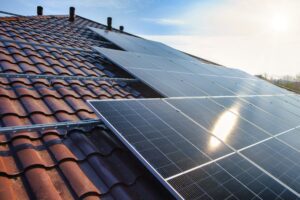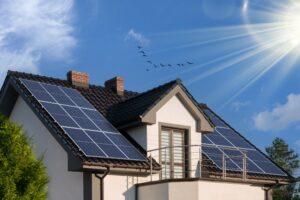Increasing numbers of households are installing rooftop solar panels to get free electricity. But they’re not always a practical solution. Your roof might not get enough sun, for instance, or there may be structural concerns.
If you’re exploring the possibility of going solar and have discovered your roof isn’t suitable, all is not lost. You can install ground-based solar panels in your garden instead. Another option is a solar energy system mounted on a garden wall.
In this comprehensive guide, you’ll discover everything you need to know about garden solar panels, including the pros and cons and costs. We’ll also explore other kinds of solar panels for the garden.
Types Of Solar Panels For Gardens
The main types of garden solar panels provide an alternative to rooftop systems to power an entire house. These are installed at ground level or on a wall. They work like rooftop solar panels and generate renewable electricity by capturing light energy from the sun.
Solar panels can also be installed on garden structures such as:
- Sheds.
- Pergolas.
- Gazebos.
These largely produce limited power but some may be able to provide electricity for your house. Solar energy can also power outdoor lighting, and portable solar panels also have their uses in the garden.
- Create a Tailored Quote Based On Your Circumstances
- Takes Less Than 2 Minutes
- Fixed-Online Quotes

Ground-Mounted Garden Solar Panels
Ground-based solar panels are the go-to alternative when a roof isn’t ideal, provided your garden is large enough. They can take up around 20 to 30 square metres for an average three-bedroom home.
Ground-mounted solar systems can be configured in various installation designs to maximise use of available space. A frame or pole raises them above the ground by a few inches or a couple of metres depending on the best angle for the sun.
Frame-Mounted Solar Panels
Frame-mounted (aka rack-mounted) panels look similar to a rooftop solar installation but have a metal frame anchored in the ground. This angles the panels upwards for optimal sunlight exposure. Racked solar panels take up more space than a pole-mounted system and can be less efficient.
Pole-Mounted Solar Panels
Attaching multiple solar panels to a single pole allows them to be raised higher off the ground. This increases efficiency. Pole-mounted installations also typically incorporate a solar tracking system that follows the movement of the sun through the sky.
Advantages Of Ground-Mounted Solar Panels
Ground-based solar panels save more on your electricity bills because they’re up to 25 percent more efficient than rooftop systems. This is because they operate at lower temperatures and provide greater control over panel direction and angle to capture more solar energy.
Cleaning, maintenance and repair is easier and safer because no one has to climb onto a roof. And just like rooftop systems, ground-mounted solar panels usually last 25 to 30 years.
Disadvantages Of Ground-Mounted Solar Panels
Ground-mounted solar panels, especially rack systems, take up a large amount of garden space that could be used for other purposes such as a greenhouse or sizable flower beds or vegetable plots.
They’re more vulnerable to accidental damage than rooftop solar panels and more susceptible to shading from nearby buildings and trees. They typically cost more than roof-mounted systems.
Ground-Mounted Solar Panel Costs
Ground-mounted solar panels typically cost around 25 percent more than a rooftop system. This is because installation is more complex, requiring site preparation and infrastructure such as connection cables running along trenches.
Prices are around £8,500 to £10,200 for a 4kW-5kW system for the average two- or three-bedroom home. This compares with £5,000 to £6,000 for rooftop solar panels.
More powerful ground-mounted systems for larger properties cost in the range of £12,000 to £27,000-plus
Planning Consent
Unlike rooftop solar panels, ground-based solar systems usually need planning permission. Exceptions are available for panels that take up less than nine square metres – the equivalent of four to five panels. However, a typical three-bedroom house needs twice as many panels as that, so it’s likely you’ll need planning permission.
Wall-Mounted Garden Solar Panels
If you don’t have enough space for ground-mounted solar panels, and your roof isn’t solar-friendly, installing solar panels on a garden wall could be the answer. A boundary wall with a large surface area would be ideal.
Like ground-mounted solar panels and rooftop systems, wall-mounted garden solar panels perform best when facing south. They can be installed flush with the wall or at an angle to maximise sunlight exposure. But they’re still usually less effective than rooftop solar panels, although they generate more power during winter as they capture light energy when the sun is lower in the sky.
Wall-mounted solar panels generally cost more than rooftop systems but may last longer because they tend to be less vulnerable to harsh weather. As with ground-mounted systems, wall-mounted solar panels are easier to clean and maintain than rooftop solar panels.
If you don’t have a suitable garden wall, solar panels can be installed on the exterior wall of your house.
- Create a Tailored Quote Based On Your Circumstances
- Takes Less Than 2 Minutes
- Fixed-Online Quotes

Garden Shed Solar Panels
Installing solar panels on a garden shed makes efficient use of available outdoor space. Whether this is an option depends on factors such as the structural strength of the shed and the weight-bearing capacity of its roof.
Shed roofs aren’t typically suitable for the weight of a standard-size solar array. But most can support a 750W-1kW system. This can power lighting, small electronic devices, low-power appliances, and electric vehicle charging.
Larger shed roofs may be able to accommodate a more powerful solar system to provide electricity to run a small home.
Smaller solar panel systems for sheds cost around £1,800. They can reduce electricity costs by £40 to £80 a year. Larger systems come in at £5,500 to £6,000 and can save £400 a year on energy bills.
Pergola Solar Panels
If you have a garden pergola with a roof, installing solar panels on it can provide enough electricity to power your house on a sunny day, saving about £70 on annual energy costs.
Some pergolas can support the weight of up to 10 solar panels if there’s sufficient roof space. Many households install around three panels on their pergola, however. These can power lighting, ceiling fans, and a laptop. Larger systems can power part of your home, or all of it at peak output.
Pergola solar panels cost about £350 to £500 a panel plus £300 to £600 for installation.
Gazebo Solar Panels
If your gazebo can support the weight of solar panels, they can provide enough power to charge electronics, for outdoor lighting and music systems, and to heat a pool.
Solar panels for gazebos generally cost around £8 to £12 a square foot of surface area.
Solar Panels For Garden Lighting
LED (light-emitting diode) lighting powered by solar panels is simpler and safer to install than a mains supply system. And the free electricity can provide ornamental and functional lighting throughout your entire outdoor space.
Types of solar garden lights include:
- String lights to illuminate trees, fences, patios, and canopies. Many LED string lights change colour and/or come in decorative shapes.
- Lights for patios, decking areas, and steps.
- Lighting for doorways and entryways.
- Landscape spotlights.
- Pedestal lights to showcase flower beds.
- Lighting for garden water features and fountains.
- High-power solar garden floodlights activated by motion sensors as a security measure.
Portable Solar Panels In The Garden
Although portable solar panels can’t power a house and are intended primarily for outdoor activities such as camping, their limited capabilities could be handy in the garden, especially if you like to make the most of your outdoor space.
A standard-size portable solar system paired with a battery can run electronic devices such as smartphones, laptops and tablets. More powerful setups can power appliances such as microwaves, mini-fridges, hot plates, kettles, and portable TVs, plus garden power tools such as lawn mowers and hedge trimmers.
Portable solar panels are smaller than regular solar panels, both in physical dimensions and wattage power. Rooftop solar panels generally have power output of 250 to 450 watts and are typically about 1.6 metres long by 1 metre wide. Portable solar panels typically have around 100 to 200 watts of power capacity and measure about 1.5 metres by 0.6 metres.
They’re also around 50 per cent cheaper than rooftop solar panels.
Final Thoughts On Garden Solar Panels
If your roof isn’t large enough or strong enough for solar panels, or gets a large amount of shade, your garden may offer various possibilities for enjoying the benefits of solar power.
Ground-mounted solar panels or a solar system on a garden wall could supply electricity for your whole house. And a smaller solar setup on the roof of an outdoor structure such as a garden shed offers the possibility of a limited supply of solar electricity.
Furthermore, solar energy can power ornamental and functional garden lighting, and portable solar panels can help you enjoy your outdoor space to the full. Contact Effective Home today if you’re considering solar panels in your garden.
- Create a Tailored Quote Based On Your Circumstances
- Takes Less Than 2 Minutes
- Fixed-Online Quotes




